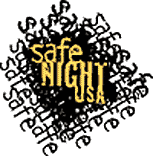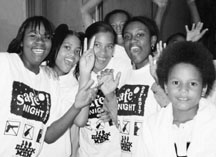Safe Night: 2,000 teen parties, no drugs, no guns
Originally published in Current, May 10, 1999
By Karen Everhart Bedford
Before the nation's attention was captured by the Columbine High School massacre in Colorado last month, community-based youth groups and public TV stations were completing plans for the first Safe Night USA, an outreach project that aims to draw more than 1 million kids to neighborhood parties across the country on June 5 to teach them about violence prevention.
The idea, originated in Harlem and adapted in Milwaukee in the early '90s as a response to rising youth homicide rates, is to give kids something fun and safe to do, connect them with youth groups working in their neighborhoods, and teach them ways to avoid violence.
Safe Night Detroit, a citywide event held last September, drew 12,000 kids to 93 neighborhood parties. (Photo: Laura Stoffel.)"This is about giving communities a new tool to deal with whatever their issues are," says Maria Alvarez Stroud, project director for Wisconsin PTV, which is spearheading the project. Some 2,000 Safe Night events are being planned in communities across the country.
A "Safe Night" is a party or special event, organized locally by youths and adults, at which participants must abide by three rules: no weapons, no drugs or alcohol, and no fighting. The essential element of each event--whether it be a beach party, athletic tournament, talent show or dance--is an educational component on resolving conflict, managing anger or avoiding violence, sandwiched in the middle of a celebration of youth.
"It will have a message," says Olusegun Sijuwade, a public health educator and former policeman who adapted the Safe Night concept for Milwaukee. "The fact that it has a message screens out people who come looking for trouble." Since 1994, some 500 Safe Nights have been held in Milwaukee, drawing both kids who are at-risk, and those that never get into trouble.
"We've had reports from organizers that kids who were borderline decide that a group offering a Safe Night has more to offer than drugs or a gang," says Sijuwade. "Kids can live five blocks from a youth center or boys or girls club and not know it. They discover something that they can do." Safe Nights have been credited with helping to lower the city's youth crime rate by 60 percent.
Through its Act Against Violence outreach campaign, Wisconsin PTV launched the Safe Night program statewide in 1996, broadening awareness of youth violence as an issue affecting all communities.
In small towns, problems associated with youth violence are "more hidden and not thought of as a problem," explains Stroud. Kids are bored and don't know what to do with themselves, so they "go drinking in a cornfield." A year after the first "Safe Night Wisconsin," the network followed up with its community-based organizers and found that nearly 50 percent of them continued to hold events.
"It's an idea that went so well in Wisconsin that we thought it would translate to the national level," Stroud adds.
"This applies to rural youth, suburban youth and urban youth," says Joan Hollendonner, senior communications officer for the Robert Wood Johnson Foundation, which backed the national launch of Safe Night. The foundation views Safe Night as a "vehicle to raise awareness of youth substance abuse and violence, and involve communities in addressing it."
The community "owns it"
A live television program airing simultaneously June 5 on PBS and the BET cable network will connect Safe Night events held around the country. TV stars Wayne Brady and Doug E. Doug will cohost the one-hour program, and special guests and performers (among them, Olympic Gold Medalist Dominique Dawes and the hip-hop group Naughty by Nature) will reinforce Safe Night's anti-violence message.
"It will have the real flavor of a celebration across the country, that we're all taking steps to make kids safe one night at a time," says Stroud.
Thirty-seven public TV stations in the top 40 markets will broadcast "Safe Night USA," covering 90 percent of the country.
Some public TV stations will simply broadcast the program, while others are also helping to plan events. Outreach coordinators at several stations credited local groups for working together to make Safe Nights happen in their communities, and for tailoring activities to the needs and interests of local youths.
"It's really in the hands of the community," says Kathleen Acord, project supervisor at KQED's Center for Education. Safe Night provides "general guidelines and a platform," for youth groups to decide what they want to do. "They really own it. It really is something that they have created themselves."
She credits Berkeley organizer Salvadore Murillo for using his connections to pull together "really strong events" such as a girls' twilight basketball tournament, a poetry reading, dances and a student recognition awards ceremony. KQED has scheduled a block of anti-violence programs for the evening of June 5, and Berkeley's public access channel will also telecast a live special featuring local youth.
"What we're talking about is a grassroots effort," says Mari Cossaboom, associate director of research at WNET, New York. "It's community groups who can take this on and really make it happen." She describes WNET's role as part of a "community-lead coalition," helping to plan and promote Safe Night events throughout New York City.
"One thing that I really like about Safe Night is that people are using it as an opportunity to create ongoing coalitions," says Judy Flavell, community outreach coordinator for Kentucky ETV. "Young people and adults are working together," some to plan Safe Night events throughout the summer. Paducah, Ky., a town shocked by a school shooting in 1997, is planning one of 30 Safe Nights to be held throughout the state.
"A lot of our contacts came out of the original Act Against Violence [public TV outreach] campaign and the Moyers series [Moyers on Addiction: Close to Home]," says Dan Flenniken, director of education for Rocky Mountain Public Broadcasting (KRMA) in Denver. Since the Littleton shootings, KRMA decided to schedule the Safe Night broadcast; its sister station KRMJ in Grand Junction —some 300 miles away —has been working with youth organizations to plan a Safe Night event in conjunction with a junior college baseball tournament to be held in the city. "It's nice to focus in on one community, and it's not so big that you can't make an impact."
The Act Against Violence campaign was the "biggest outreach project ever undertaken" by RMPB, says Flenniken. The project received generous support from the Colorado Trust and developed a violence prevention seminar for youth, and a media literacy curriculum on critical viewing skills for fourth-through-sixth-graders, among other elements. The media literacy package includes a 30-minute general audience program and four short programs for instructional use. RMPB plans to offer it for national distribution through GPN this summer.
"A lot of people, including ourselves, are thinking about what we could have done to stop this rampage from happening," adds Flenniken, referring to the shooting deaths of 14 high school students and one teacher in Littleton on April 20. He sees possible role for RMPB in helping educators learn how to identify troubled youths who may be prone to violence.
"Built into the community"
Coverage of the Littleton shootings zoomed in on the grisly details of the massacre inside of Columbine High and the public mourning of an entire community. We've heard about possible causes of youth violence, but very little about how to address them effectively.
"More airtime is given again to the violence," comments Linda Lantieri, director of Resolving Conflict Creatively Program, an initiative of Educators for Social Responsibility that teaches nonviolent conflict resolution to young people in 350 schools. During the Act Against Violence campaign, RCCP was identified as a model violence prevention program. It is now a national partner in Safe Night USA.
Safe Night USA is "not meant to be a one-time thing," she says. "It's meant to say there's something very concrete that communities can do for youth. The degree to which youth are involved in the process is the degree to which it will take hold in the community."
Lantieri says public TV's efforts in violence prevention have helped to "highlight some of the myths" surrounding the issue, and presented some positive solutions, RCCP included.
During a Safe Night Wisconsin event, teens listen to a lesson on peaceful conflict resolution. (Photo: James Gill.)To measure the effectiveness of Safe Night USA, Wisconsin PTV will conduct a two-pronged evaluation of the project. A survey of organizers, completed after their events, will gather general information about the number of participants and the success of the activities they planned. Researchers will also gather feedback from kids on the educational elements presented at a random sample of Safe Night sites.
"We'd like to see if the different things that organizers chose to focus on had differential effects," explains Joanne Cantor, an expert on children's reactions to media and an adviser to Safe Night USA. Cantor's recent book, Mommy, I'm Scared, details how media violence affects children at different ages, and advises parents how to help children deal with fears created by television or movies.
While media have been widely targeted as "a major contributor" to the problem of youth violence, Cantor says Safe Night USA is a way for media to be part of the solution. "What I like about it is that it's built into the community. It's getting people together who can work together and continue what Safe Night started."
"I don't think any television program can have that much effect in and of itself, unless it can mobilize a community to work day by day on a problem."
Web page corrected May 17, 1999
Current
The newspaper about public television and radio
in the United States
A service of Current Publishing Committee, Takoma Park, Md.
E-mail: webcurrent.org
301-270-7240
Copyright 1999



